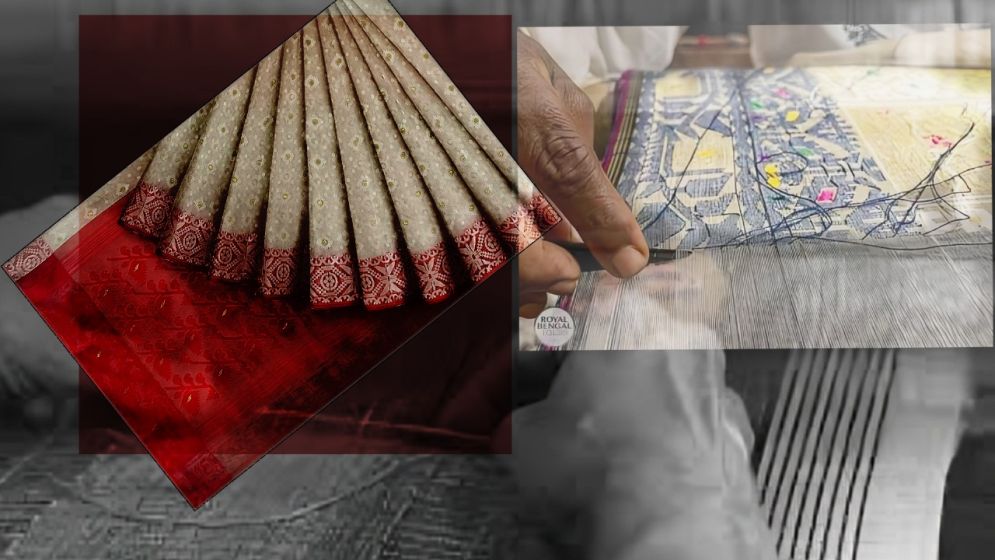The song of Jamdani will fall silent…unless you pay its true price

There is an art form–ancient, intricate, and astonishing–that may not live to see another generation: Jamdani saree.
So, I urge you to buy a Jamdani saree. For your mother. For your daughter. For the love of anything still made with human hands. Because if we continue on this path, Jamdani will vanish. And with it, a legacy.
Few products of Bengali craftsmanship have truly stunned me, but Jamdani does–every time. It is not just mere clothing; it is poetry woven into fabric. At its best, a Jamdani saree rivals anything you might find hanging in a museum–sophisticated, versatile, transcendent.
This isn’t hyperbole. Under the patronage of the Mughals, Jamdani–woven from the finest cotton called kapas, native to the lush floodplains of Bengal–achieved global renown.
The rivers surrounding Dhaka nourished the cotton and the artisans alike. Their water added a natural sheen to the threads, while the soil’s heat and moisture nurtured the raw material. From these perfect conditions emerged sarees so light and sheer they were said to float in the air.
The Julahas–the master weavers–turned thread into marvels.
But then came the British. And with them, the factory. Colonial trade policies flooded Bengal with cheap industrial goods. The handlooms fell silent. Weavers could not compete with machines that did in hours what once took them months.
Entire economies collapsed. And still, somehow, a few stubborn artisans refused to let Jamdani die.
They are still weaving today–but just barely. The tradition is endangered not because it lacks beauty or demand, but because it lacks support. The average artisan earns a pittance. Their children don’t want to inherit poverty. Who would?
And here's the non-negotiable truth: Jamdani cannot be mechanized. Attempts to replicate it by machine–in India or elsewhere–produce lifeless fabric. Devoid of soul, devoid of artistry.
Because some things simply cannot be mass-produced. Jamdani, like all the most exquisite things in life, must be made by hand.
-68517b7f04466.png)
The real cost of Jamdani
Let’s do the math.
Not the price tag, but the true cost–the human cost–of a Jamdani saree. And I’m not talking about the tourist-market stuff. I mean the finest, the kind of piece you’d gift a head of state.
For that, two weavers–one a master, the other an apprentice–work side by side for up to 12 hours a day. And they do this not for a few weeks, but for six to eight months. Yes, months. For one saree.
What do they get for it? About 1.5 lakh taka. That’s around $1,200. And that includes time lost on waste yarn, failed attempts, revisions. A less intricate saree might take three months and earn the weavers just 30,000 to 50,000 taka—roughly $250 to $430.
We’re talking about full-time labor by multiple artisans for wages that barely cover living expenses. This is not commerce. This is exploitation wearing the mask of tradition.
And for anyone tempted to think, “Well, it’s Bangladesh, things cost less”--let me introduce you to the Panama hat.
A good one–made from a relatively cheap tree bark straw–will run you a few hundred dollars. Like Jamdani, what drives the price is labor. But the top-tier Panama hat? That’s a different world entirely.
It’s called the Superfino Montecristi, and it’s graded. That means you can count the weave: 40, 50, even 60 threads per inch, yielding an astonishing 1,600 to 2,500 interlaces per square inch. It looks less like a hat and more like silk.
One artisan–just one–works on it by hand, for three to four months. That hat sells for $25,000. The weaver walks away with $6,000 to $10,000.
And yet, our Jamdani–handwoven for up to eight months by two artisans, from a tradition centuries older–sells for $2,000 if you're lucky. Most weavers earn a fraction of what their time and talent deserve.
We’re not just undervaluing the product. We’re erasing the weaver.
-68517b99301f8.png)
The underlying problems
The problem is Jamdani has no formal grading system as of now.
No standard of excellence. No international marketing campaign. No lobbyists. No price protections. No fanfare. And without urgent intervention—no future.
Yes, it was declared a UNESCO Intangible Cultural Heritage of Humanity in 2013 but that does barely change the fate of the master weavers.
So, it’s no surprise that Jamdani weavers are vanishing–and fast. You’d vanish too if your livelihood depended on selling a masterpiece for the price of a mass-produced bedsheet.
A saree that should fetch 1,50,000 (roughly $1,200) is routinely sold for 30,000 taka ($250). And the consequences are predictably tragic: weavers are leaving the loom behind, and they're taking their children with them.
Can you blame them? What parent would encourage their child to inherit poverty?
Now let me ask you something uncomfortable. If this saree–this exact artistry–came stamped with "Made in some foreign country" instead of Bangladesh, wouldn’t you gladly pay the full lakh? Wouldn’t you marvel at your own taste and say, “Brother, what a great deal I got!”?
Exactly. Jamdani’s greatest liability isn’t its complexity, or its cost, or even the slow pace of hand-weaving. Its liability is geography.
We don’t value what comes from within the border–not really. Not the hands that make it, not the history that shaped it, not the generations that preserved it.
If Jamdani were woven in Venice or even Varanasi instead of Narayanganj, it would be featured in fashion magazines and wedding trousseaux across the country. Instead, we treat it like a quaint curiosity–until it disappears.
If you want your daughter to one day inherit the cultural legacy of Jamdani, you need to help keep it alive now. That means buying one–directly from a weaver if possible. Pay what they ask. They know the value of their labor far better than any boutique in Mumbai or online store ever will.
You will not be cheated. No one has ever been cheated by a Jamdani.
—
Faham Abdus Salam is an Australia-based writer and commentator

